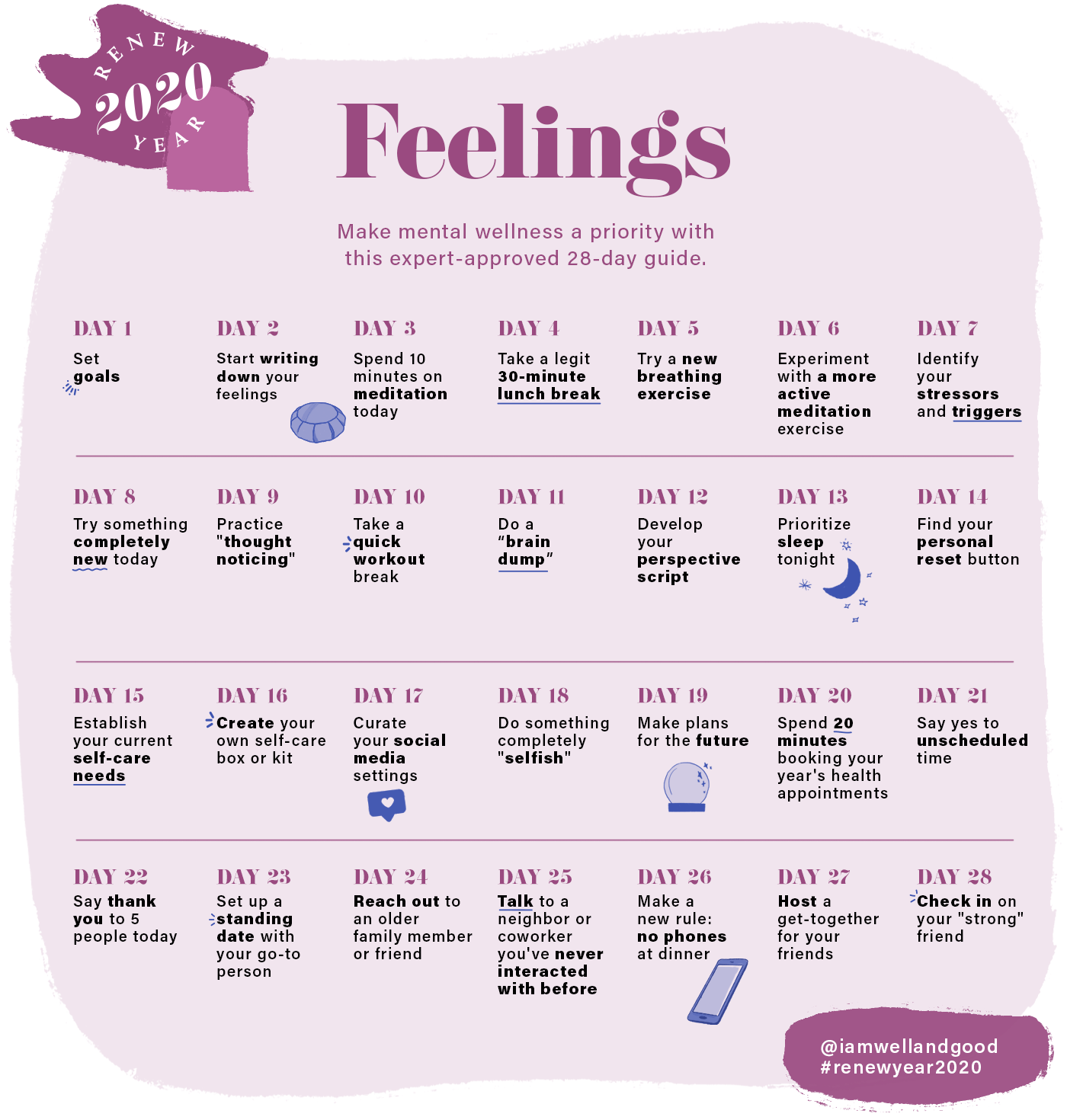
January 01, 2020 at 11:30AM by CWC
Have some empathy for the “She Doesn’t Even Go Here” chick from Mean Girls; it can be hard to have a lot of feelings—and to know how to productively channel them. That’s why, for the next four weeks, we want to encourage you to focus on your emotional health. Per clinical psychologist Carla Marie Manly, PhD, author of Joy From Fear, emotional health means being in touch with your emotional state in a “balanced, grounded way” and being aware of and able to process and regulate those emotions.
Because it takes 28 days to make a habit, we’ve compiled 28 daily tasks to help you get more in tune with your emotions and mental well-being. By the end of this month, you should have the tools to make checking in with the way you feel and the headspace you occupy a priority every single day.
Get to know the plan now, sign up for our special email to have each week’s tasks delivered to your inbox* (in the box below), and sync the plan’s tasks onto your personal calendar now. On January 5, get ready to get emotional.
ADVERTISEMENT
ADVERTISEMENTKate Spade Autumn/Winter Sale |
Keep reading for the full 28-day emotional wellness challenge:

Day 1: Set goals
It’s easy to make a resolution December 31 and have your efforts swan dive before you return to the office. So to set emotional-wellness-related goals in a manageable way, Dr. Manly says it’s best to set only one or two major (macro) goals with several very specific micro-goals related to each macro goal. “The brain’s dopamine reward system is triggered when small, achievable goals are completed, and this increases motivation to continue to work to achieve the macro goal,” says Dr. Manly. “The highly specific micro-goals give the actionable steps needed to make the sometimes very general macro goal come to life!”
So if you have a larger goal of being more positive in 2020, you might set a few smaller micro goals to work towards, like starting a gratitude practice in January or committing to daily affirmations.
ADVERTISEMENT |
Day 2: Start writing down your feelings
This doesn’t have to be a full journal of your rapidly cycling emotions, just start tracking how you feel by jotting down notes for your reference. This makes understanding your feelings easier in the moment, and can help you track progress or understand larger patterns. Can’t find a pen and paper handy? Jot what you’re feeling down in your iPhone notes.
Day 3: Spend 10 minutes on meditation today
It only takes 10 minutes to see the mental health benefits of meditation, so why not give it a try? If you’re less than jazzed about being alone with your thoughts while sitting in an annoyingly rigid posture, a guided meditation like yoga nidra could be a good intro to the practice. Just try not to doze off…
Day 4: Take a legit 30-minute lunch break
Listen, we’ve all gotten so used to that buritto-bowl-at-our-desk-life that this sounds like a radical concept. But at the urging of licensed psychologist and creator of the Inner Voice app Helene Brenner, PhD: Take a real break.
“There’s a lot of recent neuroscientific evidence to show that the brain reacts similarly to [strain] as a muscle: It gets tired,” she says. “Unless you’re adrenalized by a drop-dead deadline, you’re going to take a break anyway by checking your Instagram or Facebook account. You just won’t enjoy it as much or get as much out of it if you’re not giving yourself permission to really relax. Your body will be so grateful to you if you give yourself total permission to relax and take in nourishment, mentally and physically.”
Day 5: Try a new breathing exercise
Feeling stressed? Take a minute and tackle a breathing exercise to help calm and center you. As Dr. Manly points out in Joy From Fear, panic breathing is short and shallow, which is why being mindful about how you inhale and exhale can ground you in the present moment.
She recommends extended cleansing breaths. Breathe in deeply and fully, then lengthen the inhalation for two more counts. Breathe out as deeply and fully as possible, and then continue the exhalation for two more counts. Relax and pause, then repeat five slow cycles of breaths.
Day 6: Experiment with a more active meditation exercise
Sitting still for a traditional meditation can be hard for some people (or in some cases, triggering)—branch out and try another activity that promotes mindfulness, like an art class, cooking a meal, yoga, or oooh! Maybe make an adult friendship bracelet?
ADVERTISEMENT

ADVERTISEMENT
Anya Hindmarch - I AM A PLASTIC BAGDay 7: Identify your stressors and triggers
Knowing what specific things in life that particularly stress you out or derail you—like raised voices or certain kinds of passive-aggressive remarks—can help you better address them when they come up and be more mindful of how to handle them. One good way might be to write them down and, especially if you’re in a relationship, share them.
“Dr. Sue Johnson, the developer of Emotionally Focused Couples Therapy, calls this your ‘raw’ or ‘tender’ spot,” Dr. Brenner says. “Talking about what happens to you, what you tend to do when you get triggered, why it happens to you, apologizing for your over-reactions and inviting your partner to share what happens to them when you react that way and what their triggers are, is a great way to get closer and to understand each other at those moments when you are least lovable, yet deep down, most need your partner’s understanding.” This could absolutely apply to other close relationships too, like with friends or immediate family.
Day 8: Try something completely new today
Whether it’s a new experience, new food, or new skill, challenging your brain with something unexpected can help release more dopamine and engage different parts of your brain—which is crucial to keeping your mind active and flexible. Likewise, the element of novelty or the “oddball effect” will make your day feel delightfully longer (in a good way, promise).
Day 9: Practice “thought noticing”
Thought stopping is a cognitive behavioral technique that reduces negative thinking. The general concept is that when you get in a cycle of persistent negative thoughts, you envision a red stop sign every time such a thought appears in your head in order to halt it in its tracks. But Dr. Manly says some research has shown that thought stopping without replacing the negative idea with a positive one can increase certain negative thoughts, which is why she finds the cousin technique of “thought noticing” to be much more effective.
“When a negative thought arises, simply notice, non-judgmentally, that it is present,” Dr. Manly says. “Then, offer the mind a replacement thought that is positive, such as focusing on an uplifting mantra, a beautiful picture, or an upbeat song lyric. This strategy distracts the mind from the negative thought and, as it does not forcefully suppress or stop the negative thought, it reduces the chance that the negative thought will recur later.”
Day 10: Take a quick workout break
Physical activity comes with tons of mental health benefits—harness those in your favor by making time for a 10-minute workout.
Day 11: Do a “brain dump”
Write down the stuff that’s on your mind today, including the things that are worrying you or stressing you out. Research shows that when you get it all out of your system, it can help unburden you and feel freer to get things done. Just make sure to throw the list away so you don’t fixate.
Day 12: Develop your perspective script
It’s easy to get overwhelmed and stressed when things are piling up. Sometimes, putting things into perspective can help you get out of a worry spiral. Dr. Brenner suggests doing so by asking yourself questions like, “How critical will this be in six months?” or “‘Am I overdoing it?’” You can ask this of yourself, or you might want to ask a trusted loved one who will tell you the truth. If the honest answer is “yes,” follow up that question by asking yourself, “Do I really have to?” and, if the answer is still yes, then ask “Why?” Going through these questions and knowing your answers will help you better prioritize what’s on your plate—and may even take some things off of it entirely.
Day 13: Prioritize sleep tonight
Giving your brain a rest is crucial for overall better physical and mental health. Try a sleep tracker if that’s your thing to assess your sleep habits, and make sure that your bedroom is primed for optimal sleep (read: dark, cool, and quiet). Don’t forget to investigate what other changes you can make to promote a better night’s sleep:
- Put away digital devices at least two hours before bed
- If you’re drinking, have your last drink at least two to three hours before bed
- Eat your biggest meal earlier in the day for optimal nighttime digestion
- Load up on sleep-promoting foods
- Consider melatonin or magnesium supplementation
Day 14: Find your personal reset button
In the Sims, hitting reset on a glitching character will have them do nothing for a minute before returning to a normal, neutral state. “Doing nothing” could also be considered a reset button to get you through a day when you’re overwhelmed. Other reset buttons could include deep breaths, five minutes of Pinterest time, taking a quick walk, or calling your friend and venting.
It’s good to have a variety of reset options, says Dr. Manly. “It’s important to know that a reset button may work well in some situations and not terrifically well in others—conscious awareness and flexibility are key,” she says. “So, if you use a reset button and you feel better afterward, you know you’ve hit a sweet spot. But if you use that personal reset button and you don’t feel better, use another mode until you find one that gives you the sense of joy and relief you want and deserve.”
Day 15: Establish your current self-care needs
Take a tip from Elisa Shankle, interior designer and co-founder of HealHaus, and audit your self-care practices to see which ones are effective. First, list your current go-to self-care practices. Then, think through which of them you’ve found truly joyous and beneficial within the last few months, and which ones have fallen flat. Maybe face-masking is less satisfying than it once was, or maybe you don’t feel any better after a Great British Baking Show marathon. These kinds of revelations can open the door to trying other self-care methods.
Day 16: Create your own self-care box or kit
Once you’ve figured out what your current needs are, create a self-care box filled with five special items that you only use on days you particularly need a little TLC. These can be comforting things like a soft blanket, or a favorite book, or maybe the boxed DVD set of Gilmore Girls. Whatever brings you comfort, you should consider putting in your self-care box.
Day 17: Curate your social media settings
Taking care of yourself sometimes means unplugging or overhauling how you interact with social media. Don’t know where to start? If you’re feeling sensitive, clinical psychologist Goali Saedi Bocci, PhD, says to nix any overly negative or positive friends (yep, seeing relentlessly cheerful posts can harm your psyche, too), but keep inspirational strangers and celebrity role models who make you feel good.
Day 18: Do something completely “selfish”
Many of us put other people’s needs first, whether it’s our partner, family, friends, or coworkers. Today, we want you to do something completely for you, by yourself! We’re really big advocates of the solo date, which entails getting out and doing your favorite things to help you get in touch with what brings you joy and excitement. You deserve it.
Day 19: Make plans for the future
We both know that it’s healthy to practice mindfulness strategies to keep us present, butsometimes the present moment just kind of… sucks. Having your brain wander in that state might have us looking toward the future with a worried mind, which can cause stress and anxiety.
“However, when we look toward the future with delight—such as planning a beautiful trip to Paris—the mind is set free from the stresses of the here and now,” Dr. Manly says. “So, whether actually planning the trip or simply fantasizing about the delightful journey to come, the mind and spirit truly benefit from the positive energy and imaginings that arise. When we engage in positive, uplifting thoughts about the future, the brain is flooded with feel-good neurochemicals that give relief from everyday stressors.”
So whether it’s planning your next vacation, buying cheap concert tickets, or scheduling your next pedicure, thinking toward the future can be self care, too.
Day 20: Spend 20 minutes booking your year’s health appointments
It feels almost too obvious, but self care can involve taking care of your physical health, too. Set aside some time today to call your doctor’s office, your OB/GYN, and your dentist to get your yearly wellness check-ups on the calendar for this year. (If your phone anxiety is through the roof, try ZocDoc.)
Day 21: Say yes to unscheduled time
Our lives are so hectic, taking care of yourself can sometimes mean giving yourself an entirely unstructured day with no plans. Dr. Brenner says this allows you to get out of “task mode” and go into “receptive mode,” where your mind can work on problems in the background and come up with answers you never would have gotten if you slaved over them.
“Spacious time can open you up to your inner voice, your more subtle thoughts and feelings, and can activate the desires, hopes, and dreams that you’ve put on the back burner,” she adds. “They can take you out of the silo of your daily life and remind you of what’s truly important. They can help you to ‘zoom out’ and get a larger perspective on your life, see what you truly want to do and where you truly want to go.”
Day 22: Say thank you to 5 people today
There are so many effective ways to practice gratitude, so we’re not about to tell you that counting your blessings in your journal is a bad idea. But expressing gratitude is also a key component of mental well-being because it promotes positivity.
“By bringing action—rather than just internal thought—into the equation, the mind and body both become involved in the act of being grateful,” Dr. Manly says. “On another level, when we express gratitude to another person, their positive response—such as kind words, a smile, or a hug—reinforce the positive, feel-good energy of the gratitude process. On a neurobiological level, this gratitude feedback loop becomes powerfully engaging and uplifting.” So you know, really let your barista know that you appreciate the heart on your latte. And tip, please!
Day 23: Set up a standing date with your go-to person
Maintaining strong relationships is so important for your overall emotional health, and as Dr. Brenner points out, research suggests that chronic loneliness is an actual risk factor in premature death.
In-person meet-ups are great for that big old oxytocin rush, but if you’re separated by thousands of miles from your best friend, just try to book routine phone dates. “Making appointments to get together with friends is an important process in a busy, hectic world,” Dr. Brenner says. “I myself have three scheduled ‘dates’ with friends, either in person or by Skype. A regularly scheduled date becomes part of your routine, and life begins to work its way around the appointments.”
“Texting is a perfectly fine supplement, and can give two people who are separated the ability to feel as though they are still together, but by itself it doesn’t give the same sensory fuel to the limbic system [the part of the brain that controls our emotional responses],” she adds. “It relies upon the imagination, like emails and old-fashioned letters do, to create the sensation of the person being with you, but over time it wears off.”
Day 24: Reach out to an older family member or friend
Friendships between generations are crucial for having a different kind of perspective and mentorship in your life. And lest we forget, the loneliness epidemic seriously impacts the elderly.
Dr. Manly recalls how she recently connected with a woman at the post office during a particularly exhausting day. An older woman standing behind her asked a question about package labeling, and inadvertently opened a door to conversation. “By the time I reached the front of the long line, I knew she was 86 years of age, that she had made it through cancer in 2017, that her son was 56 and battling two forms of cancer, and that she grew up in Minnesota in a family of 12 children,” Dr. Manly says. “I also learned that she wishes she lived in a less technology-oriented world—and that she wishes people had more real conversations.”
The exchange was so uplifting, and reminded Dr. Manly of the importance of connecting in small ways. “When I finished at the counter, I went to her and offered a hug and blessings,” Dr. Manly says. “She smiled with huge joy and hugged me in return—and thanked me for listening and caring.” So take today to reach out to your grandparents, an older coworker, or someone else you care about to talk and catch up. Their delight (and yours) will be contagious.
Day 25: Talk to a neighbor or coworker you’ve never interacted with before
Challenge yourself to establish more of an emotional connection with someone in your day-to-day whom you don’t often speak to, like a neighbor or coworker. “Put your phone in your purse or pocket, and offer a kind, gentle smile as you make an authentic comment about something you’ve noticed or a question you have,” Dr. Manly says. “‘What a lovely scarf!’ ‘What a long line!’ ‘Do you work nearby?’ ‘This is my favorite coffee shop!’ Simple, genuine offerings from the heart can begin a conversation that builds kindness and joy.”
Day 26: Make a new rule: no phones at dinner
Oh, and by the way, pocket your phone when you’re catching up with someone (or, hello, are on date night). Encourage IRL connection with the people you’re spending time with by banning phones during meals together. Place all your phones in bags and don’t let anyone use them during your catch-up.
Day 27: Host a get-together for your friends
Slumber parties were the best when we were kids—why can’t we do this as adults? Invite some of your closest friends over for a sleepover complete with a movie marathon, fun snacks, and staying up all night talking. The nostalgia factor will bring you closer together, so don’t forget the French braids and butterfly clips! If this is a hard ask for people with kids or just busy schedules, make it a dinner party at your house or a group hang at your favorite restaurant. Just making time to connect IRL with your favorite humans is crucial.
Day 28: Check in on your “strong” friend
Even “strong” people need some care, especially when they’re going through a hard time. But when you check in with someone about their mental or emotional health, it’s less about what you say than how you say it. “You can say, ‘how have you been?’ or ‘how has it been going lately?’ in a way that conveys that you really want the truth,” says Dr. Brenner. Slow down, look directly at the person, and show that you’re not in a big rush to move on.
If you still get an “Oh, I’m fine” or “Don’t worry, I’m okay” and you don’t believe it, you can follow up with an empathic imagining statement, which goes something like this: “I imagine it can’t be easy to cope with your new job/your brother’s legal troubles/your in-laws staying with you for six weeks.”
If they still say that they’re fine, don’t argue, Dr. Brenner says. Say “That’s great!” and tell them that you only ask because anybody going through what they’re going through would probably find it very stressful. This lets that person you care about know that the door is open to talk if or when they are ready.
*By signing up, you’ll also be added to our Well+Good newsletter.
Curious about trying out our other Renew Year plans? You’re just 28 days from being stronger than ever—and more money-savvy, too.
Author Mary Grace Garis | Well and Good
Selected by CWC
ADVERTISEMENT
ADVERTISEMENTUp to 30% off Gift Sets |









